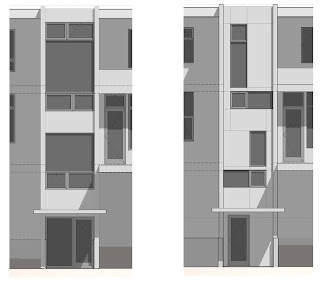The Hearth Room
We were less certain about the main living area. Anne encouraged us to start with the kitchen surfaces and the flooring since those are some of the largest and most visible areas in the house.
 In the kitchen, we gravitated toward dark brown cabinets with a white counter top. But we had to decide what type of white counter to use. We had asked Yuval to get samples of the different varieties of white CaesarStone and settled on Quartz Reflections. It has more variety and character than plain white, including metal flakes in that give it a bit of a sparkle. Anne commented that most men fear the glitter, but it is sparse, and we both think it looks nice.
In the kitchen, we gravitated toward dark brown cabinets with a white counter top. But we had to decide what type of white counter to use. We had asked Yuval to get samples of the different varieties of white CaesarStone and settled on Quartz Reflections. It has more variety and character than plain white, including metal flakes in that give it a bit of a sparkle. Anne commented that most men fear the glitter, but it is sparse, and we both think it looks nice.We will use the dark brown for the lower cabinets, and the cabinets around the appliances on the east wall. However, we want to pick a lighter color for the cabinets over the sink and back counter so that the room doesn't feel too dark. Pedini has a lot of colors available in a painted glass that looks really nice, so we're going to get some samples to help us pick a final color.
Choosing the floor material was harder. Wood comes in so many colors, textures, and finishes. We knew we wanted a fairly neutral colored wood; I don't like woods that are too yellow or too red. We liked darker brown woods, but, as we suspected and Anne confirmed, with the dark cabinetry, dark wood could lead to the room feeling too dark. I liked the very light colored woods, but Erika was less fond of them. Eventually, we settled on a fairly light brown, oiled wood that we liked the look and feel of. Oiled floors require a bit more yearly maintenance, will stain more easily, and will still dent; but they look more natural and less shiny, and develop character as they age (instead of just looking worn).
We chose Ecotech tiles for the entry. It is a sturdy tile, so we can use it both in the outdoor and indoor entry. The Ecogreen version nicely matches the wood floor on the main level, so the transition from inner entry to the main area would work well.
The Powder Room
We want the powder room on the main floor to generally match the theme on the main floor. However, the powder room is a small space not visible from other areas of the main floor and provides a chance to do something more interesting. Not crazy — our style, as Anne put it, is more 'understated elegance' — but using some interesting textures, lighting, and color combinations.
We were drawn to the Pental Glow tile. It has a fabric-like texture and a nice sheen. We chose a lighter gold that goes with the floor and white of the sink and toilet. We will run the tile up one of the main walls (probably behind the sink and mirror) and use light to bring out the texture of the tile. Anne suggested a grey paint for the other walls and ceiling. We were surprised, but it works. We will use black for accent, perhaps through some elements made of iron or blackened steel. It seems like a very unusual combination, but it should yield an elegant and interesting result.
And much more...
Even if we don't change our mind about these choices, there are still many choices to make. The south wall on the main floor is the biggest one. It will contain the fireplace, with a raised hearth for sitting and some kind of material wrapping it and extensive built-in cabinetry between the entry and fireplace. We need to decide on the interior color of the window frames, carpet colors upstairs, other flooring options for the upstairs landing and utility room, trim, paint colors on walls, the media room and other areas downstairs, and of course the stairs themselves, which will be a centerpiece of the house. Many of these choices will be delayed until the house is partially completed and we can stand in the rooms and look around. This will be an ongoing process; but we have made good progress.














